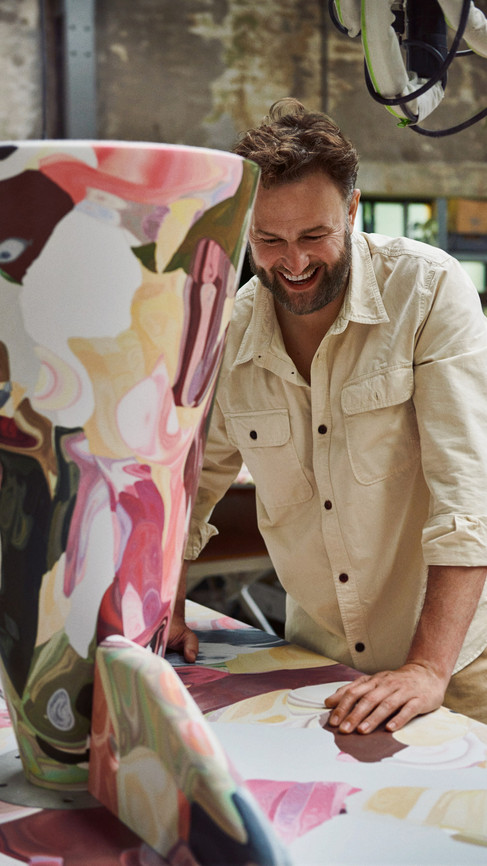Dirk van der Kooij | Designer
- Onur Çoban
- Jun 20, 2024
- 4 min read
Updated: Dec 24, 2024

The basic principles of longevity, functionality and joy guide the collections of Dutch designer Dirk van der Kooij. For each piece he creates, the designer asks: Is this a lasting and valuable application of the resources used?
In 2009 Dirk van der Kooij set up his studio in the basement of the Eindhoven Design Academy. His guiding question was seemingly simple: can plastic be an honest, durable material? Six pizza ovens welded together proved that it could. The resulting Elephant Skin series saw recycled plastic wrinkle and shrink as it cooled outside a mold, evoking a rich, vibrant tactility. The ultimate imitator had finally found an identity of its own. Elephant Skin set a precedent for subsequent works, finding new life in unexpected places throughout the collection. Discarded CDs, leather sofas, kitchen utensils, chocolate molds and rotten wood offered rich textural and structural materials.
His romance with unusual materials requires form to follow process. His series of self-developed presses, robots and extruders directly shaped the identity of the collection. The limitations of these imperfect machines gave Kooij the gift of a visual language that envelops the function, tactility and beloved strangeness of his collection. We spoke to Dirk van der Kooij, a beacon of innovation in the world of sustainable design, about his work and production practice.
Who is Dirk van der Kooij, can you briefly tell us about yourself? As a designer redefining the concept of furniture design worldwide, how did your journey begin?
Well, I don't think I would say that I am redefining the industry, but I do feel very fortunate to be doing what I love. I didn't do very well in school, always happier to be outside or working with my hands. I'm fortunate that my Dad noticed this quite early on, and had me intern with a local woodworker. From there, I began making and selling wooden furniture, and ultimately landing at Design Academy in Eindhoven. I was disheartened by how much veneer and chipboard was used in the commercial woodworking industry, so attended design school in the hopes of finding practical, beautiful, and sustainable alternatives to wood.

Meltingpot
Not just a name in the world of furniture design, but an embodiment of innovation, sustainability and artistic freedom, can you tell us a bit about your production practice? How do your products that value unique design, craftsmanship and ecological responsibility emerge with your artistic skill in 3D printing, breaking away from traditional production methods?
For a long time, I resisted designing in programmes. I felt that the work needed to be prototyped physically in order to be authentic. I no longer feel this way, and actually take great joy in designing on the computer. It makes the ideas less precious. Many of the questions surrounding quality and sustainability are answered as a group: we are now 12 people here at the studio. The collection is kept intentionally small so that we can refine and streamline production. With a certain scale (even though we are still very small) we can really hold ourselves accountable in the production process. Most recently, we've build a system to reclaim the microplastics which are made by our CNC. We can only do this when we commit to just one kind of plastic, thereby making the studio a closed loop.
"I sincerely hope that we move away from beauty as an aesthetic quality, and instead consider it as a material quality. Of course we can make bright, shiny, gorgeous objects that are an environmental scourge. But to make objects that do more good than harm, that is truly beautiful."

Fresnel
Which of your works has excited you the most in terms of the design process and the final product?
At the moment, I'm really excited about our new Staple Stool. It just one piece of bent plastic, no supports or reinforcements necessary. I am quite obsessed with this idea of pairing function and material to reveal the natural outcome of the two. In the case of the Staple, the material needs very little manipulation to function as a table or stool. I'm always searching for a best case scenario: a natural union of process and product.
What factors do you consider when researching materials or choosing materials for your new projects? Can you tell us a bit about the material choices in your work?
I find myself designing with an object's end of life in mind. Because we reclaim so much of our own material, it's simply not economical to contaminate our plastic with epoxy, fillers, or reinforcements. We need to preserve the recyclability of our material, and in doing so, we preserve the recyclability for the next generation. Our single-source plastic can be recycled over and over again.
Staple
Can you tell us a bit about the inspirations behind your work? Who are the names you follow with curiosity in this field or in different disciplines?
If I'm honest, I tend to get more excited about systems than about objects. Urban planning, housing security, renewable energy—these are my internet rabbit holes! That said, I do admire the work of the late Ingo Maurer, and more recently the work of Floris Wubben and VANTOT.
Are you excited for the future and what are your plans?
We are currently renovating our new 3000spm workshop, and I must admit, it's a bigger headache than I ever anticipated! It will be so incredible when it's finished, but I don't dare to think about that! It's very much a day-by-day process right now.

Tol
Fresnel

Gestalt

Endless Chair

Satelitte Light

Wandel

Chubby Chair

Buitenhuis










































